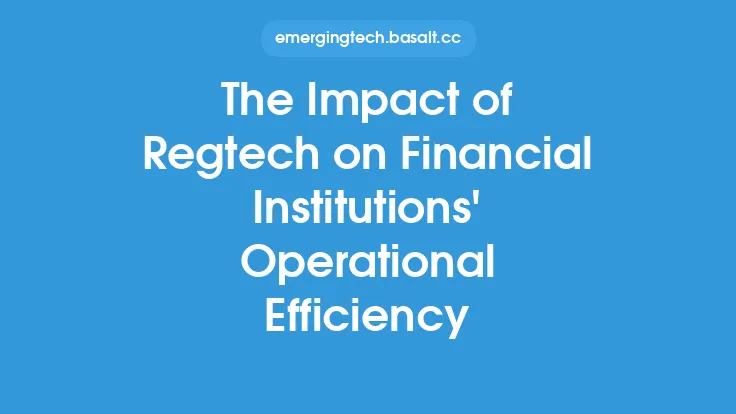The advent of cloud computing has revolutionized the way digital banking infrastructure is designed, deployed, and managed. Cloud computing provides a scalable, on-demand, and pay-as-you-go model for computing resources, allowing banks to reduce their capital expenditures and increase their operational efficiency. In this article, we will explore the impact of cloud computing on digital banking infrastructure, including its benefits, challenges, and best practices for implementation.
Introduction to Cloud Computing in Digital Banking
Cloud computing in digital banking refers to the use of cloud-based services and infrastructure to support banking operations, such as online banking, mobile banking, and core banking systems. Cloud computing provides a range of benefits, including scalability, flexibility, and cost savings, making it an attractive option for banks looking to modernize their digital banking infrastructure. Cloud computing can be deployed in various models, including public, private, and hybrid clouds, each with its own advantages and disadvantages.
Benefits of Cloud Computing in Digital Banking
The benefits of cloud computing in digital banking are numerous. Firstly, cloud computing provides scalability, allowing banks to quickly scale up or down to meet changing demand. This is particularly useful for banks that experience seasonal fluctuations in demand or need to support large-scale marketing campaigns. Secondly, cloud computing provides flexibility, allowing banks to quickly deploy new applications and services without the need for significant upfront investment. Thirdly, cloud computing provides cost savings, allowing banks to reduce their capital expenditures and operational expenses. Finally, cloud computing provides enhanced security, allowing banks to leverage the expertise and resources of cloud providers to protect their systems and data.
Challenges of Cloud Computing in Digital Banking
Despite the benefits of cloud computing in digital banking, there are also several challenges that need to be addressed. Firstly, cloud computing raises concerns about data security and privacy, particularly in the context of sensitive financial information. Secondly, cloud computing requires significant changes to a bank's IT infrastructure and operations, which can be complex and time-consuming to implement. Thirdly, cloud computing requires banks to rely on third-party providers, which can create vendor lock-in and limit their ability to negotiate favorable terms. Finally, cloud computing requires banks to comply with a range of regulatory requirements, including data protection and anti-money laundering regulations.
Technical Requirements for Cloud Computing in Digital Banking
From a technical perspective, cloud computing in digital banking requires a range of specialized skills and expertise. Firstly, banks need to have a deep understanding of cloud computing architectures and deployment models, including public, private, and hybrid clouds. Secondly, banks need to have expertise in cloud-based security, including identity and access management, data encryption, and threat detection. Thirdly, banks need to have experience with cloud-based development frameworks and tools, including containerization and serverless computing. Finally, banks need to have a robust monitoring and logging framework in place to ensure the security and integrity of their cloud-based systems.
Best Practices for Implementing Cloud Computing in Digital Banking
To implement cloud computing in digital banking successfully, banks need to follow a range of best practices. Firstly, banks need to develop a clear cloud strategy that aligns with their business objectives and risk tolerance. Secondly, banks need to conduct thorough risk assessments and due diligence on potential cloud providers. Thirdly, banks need to implement robust security controls, including encryption, access controls, and monitoring. Fourthly, banks need to develop a comprehensive data management plan that ensures the integrity and availability of their data. Finally, banks need to invest in ongoing training and development to ensure that their staff have the skills and expertise needed to support cloud-based systems.
Case Studies of Cloud Computing in Digital Banking
There are several case studies of cloud computing in digital banking that demonstrate its potential benefits and challenges. For example, a large retail bank in the United States migrated its online banking platform to a public cloud provider, resulting in significant cost savings and improved scalability. However, the bank also experienced challenges related to data security and compliance, which required significant investment in security controls and monitoring. Another example is a small community bank that deployed a cloud-based core banking system, resulting in improved efficiency and reduced operational expenses. However, the bank also experienced challenges related to vendor lock-in and limited customization options.
Conclusion
In conclusion, cloud computing has the potential to transform digital banking infrastructure, providing benefits such as scalability, flexibility, and cost savings. However, it also raises challenges related to data security, regulatory compliance, and vendor lock-in. To implement cloud computing in digital banking successfully, banks need to develop a clear cloud strategy, conduct thorough risk assessments, and implement robust security controls. By following best practices and investing in ongoing training and development, banks can unlock the full potential of cloud computing and provide better services to their customers. As the digital banking landscape continues to evolve, cloud computing is likely to play an increasingly important role in shaping the future of banking.





